
Chapter 6
Son ~ James Ware III
Just one month prior to her 18th birthday, Caty Todd Ware gave birth to her second son. He was born on what was probably a cold, wintery day on January 13, 1771. This baby was named after both his father and grandfather; hence, James Ware III.

Page taken from Ware family bible
owned by James & Judy Ware (Ref. 1)
Transcription of the above bible page - -
First Column
James Ware Born 13th January
1771
Elizabeth T. Ware 26 October 1774
Sarah E.T. Ware 1st
October 1797
Charles A. Ware 3rd July 1800
Josiah W. Ware 19th
August 1802
Harriet M. Ware 26th April 1790
James W. Ware 1st
February 1809
Bushrod T. Ware 10 September 1810
Thomas M. Ware
3rd July 1812
Lucy Catharine Ware 26th July 1814
Harriet Mary
Todd Ware 21st November 1816
Elizabeth Alexander Ware 6th November
1818
Frances Toy Glassell - July 25th, 1809 wife of Josiah W.
Ware
James Ware - son of Josiah & February 16,1831 Frances
Ware
James Alexander Ware - November 26th, 1832 son of Josiah &
Frances
John Glassell Ware May 2nd 1835 son of Josiah &
Frances
Elizabeth Alexander September 30th, 1837 Ware - daughter
of Josiah & Frances
Lucy Balmain Ware January 10th, 1839
daughter of Josiah & Frances
Charles Alexander Ware April
26th, 1841 son of Frances & Josiah
Second Column
Marshall W. McGuire March
21st, 1884
Elizabeth H. McGuire March 13th, 1886
Catharine
Ware McGuire April 5th, 1838
Edmonia Jaqueline Smith - daughter
of Edward Jaqueline & Elizabeth Smith March 7th, 1846
Jaqueline
Smith Ware -son of Josiah W. & Edmonia J. Ware February 7th, 1846
Josiah William Ware son of Josiah W. & Edmonia J. Ware July
8th, 1847
Sigismund Stribling Ware son of Josiah W. & Edmonia
J. Ware June 27th, 1849
Sigismund Stribling Ware - son of Josiah
Wm. Ware & Edmonia J. Ware February 3rd, 1851
Josiah Wm. Ware
- son of Josiah Wm. Ware & Edmonia J. Ware November 23rd, 1853
Robert Macky Ware - son of Josiah W. & Edmonia J. Ware May
5th, 1857
Lucy Ware Lewis - daughter of Edward P.C. Lewis &
Lucy B. Ware August 26th, 1866
James III came into a world bristling with anticipation of future events. His grandparents, James & Agnes Ware, had sold off most of their land holdings in the Ware Lottery just one year earlier in 1770, his parents had moved from Caroline County to Frederick County, and the American colonists everywhere were feeling more and more estranged from Great Britain. Just two short months after his birth, five Massachusetts colonists were killed by British soldiers in an incident that would later be known as “The Boston Massacre.” The hostile encounter was actually the result of tensions that had been growing since 1768 when English troops first appeared in the colonies to enforce heavy tax burdens. Bitterness was rampant, and the shootings that took place in March were a pivotal event that would bring the two factions one step closer to all out war.
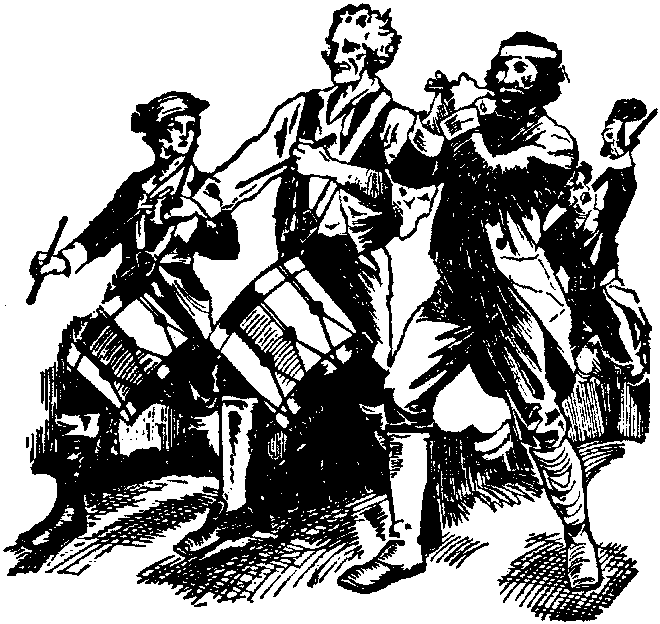
As Thompson mentioned in one of his letters, he and James “were raised and educated together” in the family home in Winchester. The brothers probably spent many childhood hours together “playing soldier” while parents spoke in hushed voices about real battles taking place not far down the road. It was an exciting time to be a young boy and also a time when young boys matured quickly. The two brothers were obviously very close, and it must have been quite an adventure when they first went with their father to see Kentucky in 1789. For James and Caty to leave both young men alone in Kentucky, at a time when it was still nothing more than a wilderness, certainly exhibits the level of confidence they placed in their sons.
Once in Kentucky, Thompson wrote, “we got separated; James located at Louisville and I in the neighborhood of Lexington, when my age was 20 and his about 18 months younger. We would sometimes accidentally see one another in the course of a year or two for several years until he entered into marriage to your mother in Virginia.” (Ref. 35E) James had “engaged with Mr. Johnson, the Clerk of Jefferson County, writing in his office until he became fully acquainted with the work.” (Ref. 6, 35G) Then “through the friendship of Daniel Morgan, James obtained an introduction to General Samuel Smith (a member of the U.S. Congress) of Baltimore. With Smith’s influence, James then commenced merchandizing in Louisville and continued in this business until 1795; laying the groundwork for the beginning of his large fortune.” (Ref. 2, 6, 35G, & 334) Inheriting his father’s
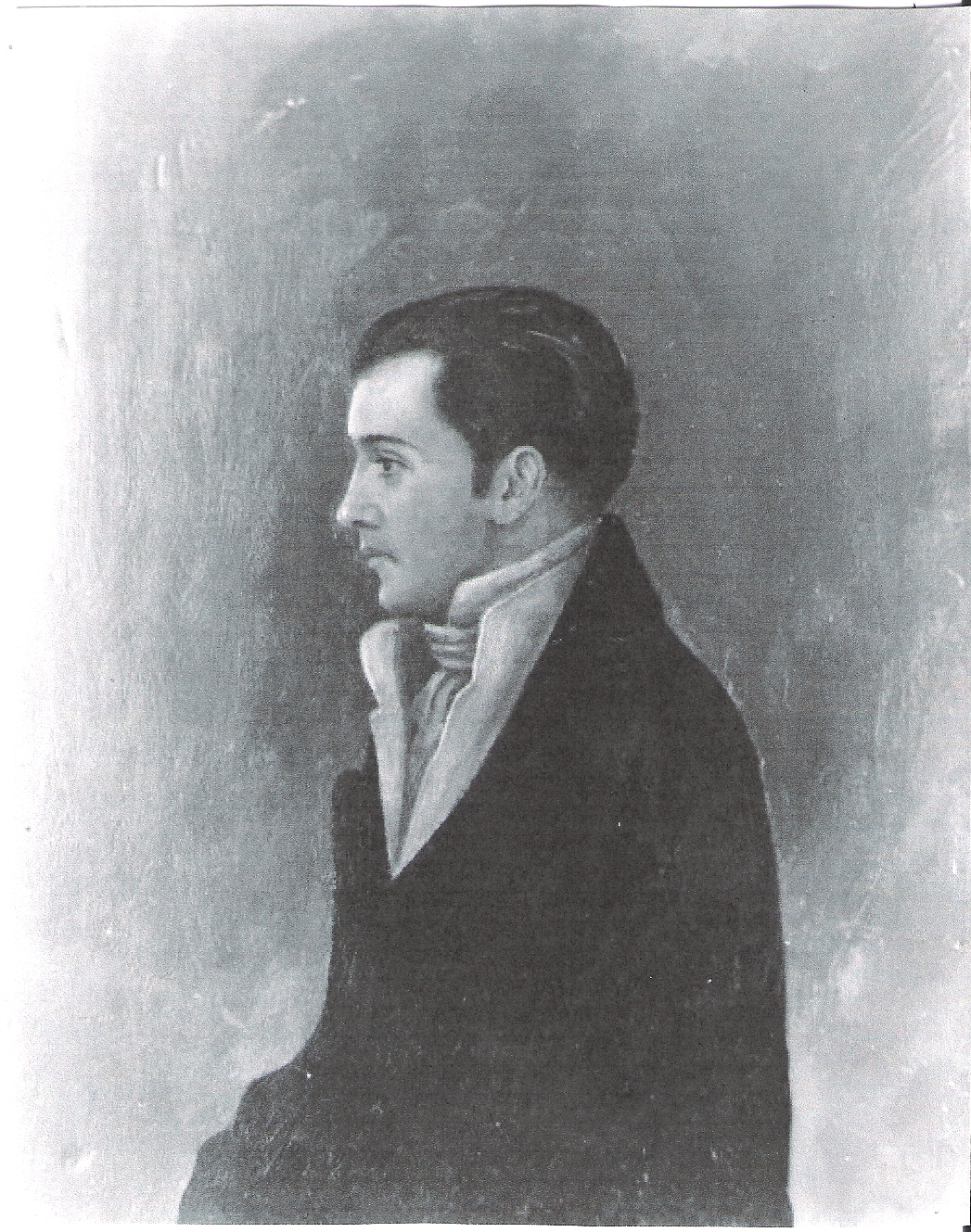 James Ware III
James Ware III
good looks and dedication to hard work, James became quite successful; his son, Josiah Ware, later writing that he “owned a great part of the town.” (Ref. #299) His health, however, was not good.
James traveled back to Virginia to help his family prepare for the big move to Kentucky. According to a letter written in 1831 by his brother Charles Ware, James “returned to Virginia in the spring of the year that my father moved here, and accompanied us some days and then returned [to Virginia].” (Ref. 35) Since he was familiar with the area and had lived there for nearly two years, he was able to assist in making the transition easier. Needless to say, it was also highly beneficial to have him along for protection.
After his parents and siblings were safely in route to their new homes, James III did, indeed, return to Virginia. Josiah later wrote that “suffering from chills and fever undermined his health, so my father sold out his business and returned to Virginia where he farmed but never recovered his health.” (Ref. 299) His health may not have been fully restored, but James III did manage to marry twice, have many children, and live another thirty years.
We now know that the symptoms James was suffering were probably the early stages of chronic tuberculosis, a disease which would ultimately kill him. Once the leading cause of death in the country, the disease was known as “consumption” in the 1700s and early 1800s due to its’ ability to “consume” the body with illness. Also called “white death or white plague,” this terrifying and very contagious malady often claimed the lives of entire families. With limited medical knowledge at the time, people were not aware of how easy it was to become infected by simply having close contact with a person already contaminated. The constant, and sometimes uncontrollable, coughing would emit water droplets in the air that were unknowingly breathed in by anyone in close proximity. As late as 1900, Louisville, Kentucky, had one of the highest tuberculosis death rates in America. Built on low swampland, the area was the perfect breeding ground for the bacteria. The disease could be fast attacking or slowly progressive and chronic. The classic symptoms of fatigue, fever, chills, and coughing were what James was experiencing while working in Louisville. With no known cure at the time, the end result of tuberculosis was always death and eventually it would claim not only the life of James, but also his wife and several of his children. (Ref. 2277)
|
In
1791, however, James was hoping that a move back to Virginia
would bring relief for his health problems. Using
the experience and money that he had amassed during his time in
Kentucky, he turned his hand to farming. He probably found
Frederick County much changed when he returned, for growth was
abounding in that area of Virginia. There was a “tavern
community known as ‘Battletown’ that had sprung up outside
Winchester. It was so named because of the frequent brawls that
would arise from the lusty frontiersmen who gathered there. In
1798 a town was properly laid out on land belonging to Benjamin
Berry.” (Ref.
790) The town would later be renamed
“Berryville” in his honor. In 1809, Mr. Berry built a home
for his daughter, Sarah Stribling, that would later become the
Battletown Inn; host to many gatherings in the small community.
It is preserved today as a bed and breakfast.
|
|
|
In
the fall of 1795, James III married
Elizabeth Taliaferro Alexander, the only
 child
of Colonel
Morgan Alexander, an officer in the Revolutionary War. Her mother
was Sarah Snickers Alexander and
her maternal grandparents were Edward and Elizabeth Taliaferro
Snickers. Grandpa Edward was a very wealthy
planter and
landowner in Frederick County. (Ref.
292)
In fact, he was such a prominent figure in the area that Snickers Gap
(in the
Blue
Ridge Mountains) and Snicker’s Ferry were named for him. In
addition, “the
village which grew up on the site of (Edward Snickers) farm was known
as Snickers Gap until 1824 when the State Assembly established it as
a town and changed its’ name to Snickersville. The name was later
discarded in favor of Bluemont in 1900.”
(Ref. 28)
James
was obviously marrying into a wealthy and prestigious Virginia
family.
child
of Colonel
Morgan Alexander, an officer in the Revolutionary War. Her mother
was Sarah Snickers Alexander and
her maternal grandparents were Edward and Elizabeth Taliaferro
Snickers. Grandpa Edward was a very wealthy
planter and
landowner in Frederick County. (Ref.
292)
In fact, he was such a prominent figure in the area that Snickers Gap
(in the
Blue
Ridge Mountains) and Snicker’s Ferry were named for him. In
addition, “the
village which grew up on the site of (Edward Snickers) farm was known
as Snickers Gap until 1824 when the State Assembly established it as
a town and changed its’ name to Snickersville. The name was later
discarded in favor of Bluemont in 1900.”
(Ref. 28)
James
was obviously marrying into a wealthy and prestigious Virginia
family.
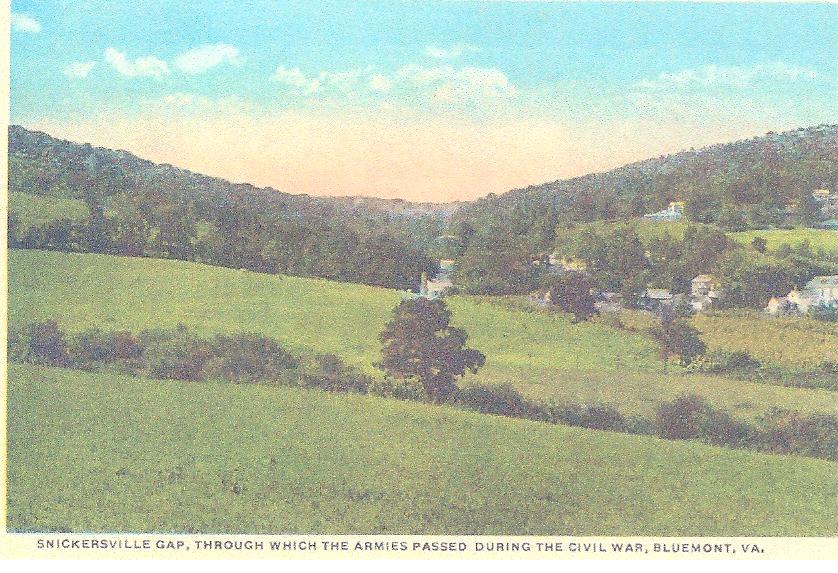 Snickersville
Gap
Snickersville
Gap
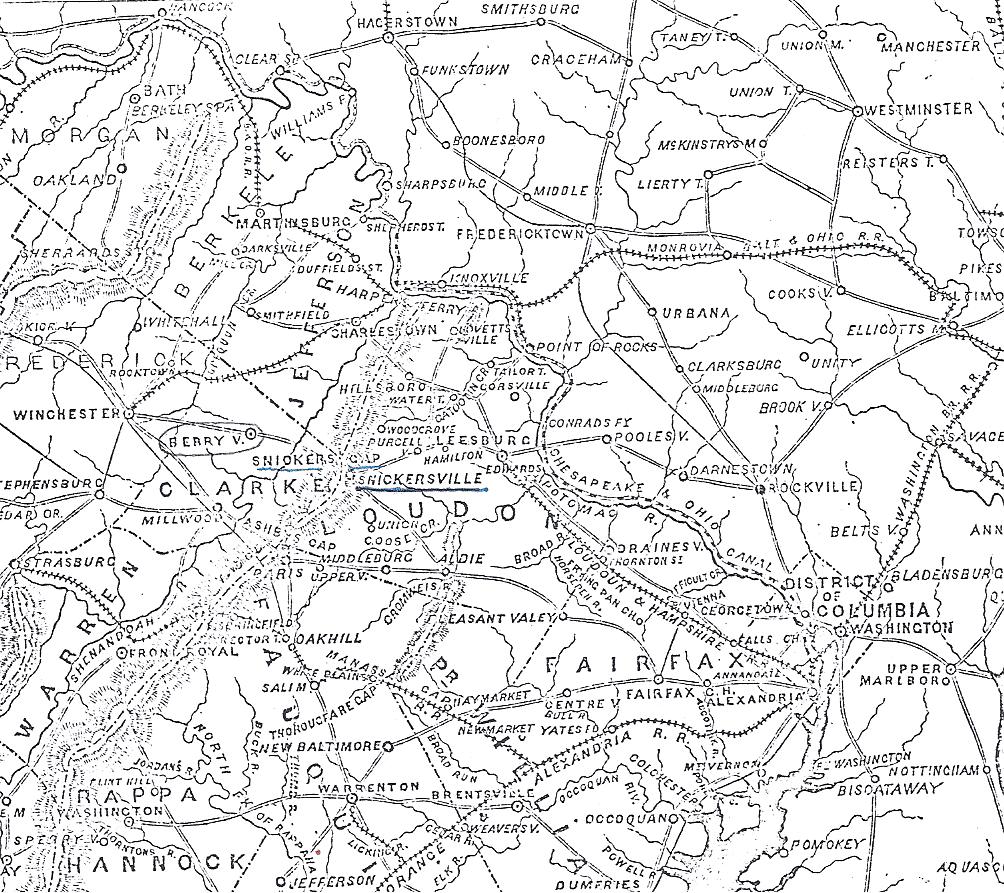
Map showing the area when it was still called Snickersville
Elizabeth’s father, Morgan Alexander, came from a family who had also relocated to Frederick County from the Tidewater region. He and Sarah Snickers were married on February 12, 1773. By 1774, the young couple had taken over management of a tavern, sometimes called an Ordinary, owned by Edward Snickers, Elizabeth’s grandfather. In November 1774, George Washington wrote in his diary: “Set out for Frederick in order to sell Col. Mercer’s estate in that county. Dined at Morgan Alexander’s Ordinary.” (Ref. 177, 493) This notation from Washington shows that Mr. Snickers had probably turned over the operation of the tavern to his son-in-law at this point. There were several other entries in Washington’s diary that mentioned lodging and dining there. (Ref. 177)
Morgan Alexander was “appointed Captain by the Committee of Safety of Frederick County in the latter part of 1775,” and in the next few years, he played a significant role in the Revolutionary War. (Ref. 2287) “The 2nd Virginia Regiment was authorized by the Virginia Convention of 1775 as a force of regular troops for the Commonwealth’s defense. It consisted of seven companies and Capt. Morgan Alexander was listed as head of the 7th Company, Rifleman that was raised in Frederick County on November 27, 1775.” (Ref. 180, 468) Morgan “received his commission in the regular army on February 1, 1776, and General John Smith, a witness, knew him to be in service in 1777.” (Ref. 2287) He “rose to the rank of Major in the 8th Virginia Regiment during the Revolution and in 1778, he commanded an expedition against the Tories.” (Ref. 492, 2153) He then “served in both 1781 and 1782 as Colonel of the Virginia Militia.” (Ref. 1098) What could have been a brilliant military career ended abruptly with Colonel Morgan’s death in 1783. According to General Smith, “he died in service.” (Ref. 2287) Colonel Alexander left Sarah a widow at the age of 27 with one child, Elizabeth. (Ref. 492) Young Elizabeth Alexander was only nine years old when her father passed away so she must have missed him sorely as she grew up.
James Ware III met Elizabeth Alexander while in Virginia. They were married on November 10, 1796. James was 25 and Elizabeth, born on October 26, 1774, was 22 years old at the time.
![]() Bible
birth entry for Elizabeth
Bible
birth entry for Elizabeth
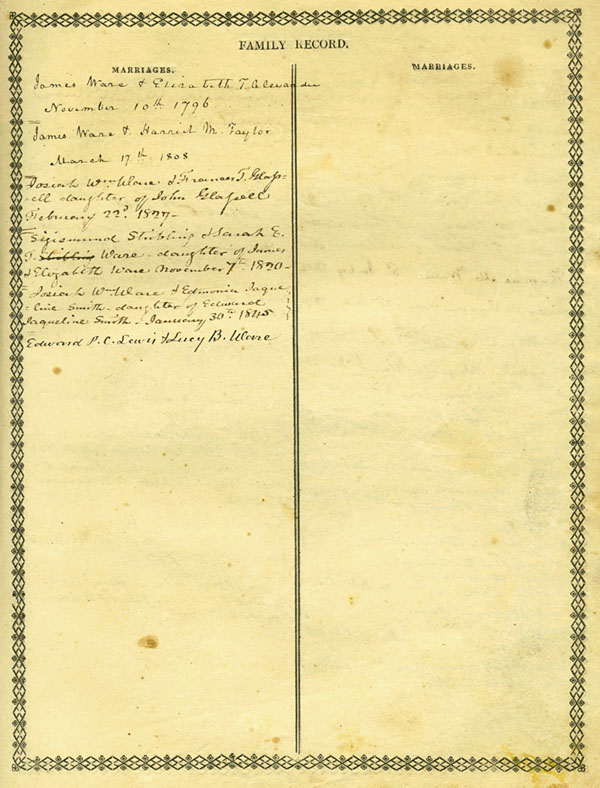 Original
bible page Bible
owned by James & Judy Ware
Original
bible page Bible
owned by James & Judy Ware
 Enlarged
and cropped copy
Enlarged
and cropped copy
Transcription of bible page for marriages:
James
Ware & Elizabeth T. Alexander November 10th, 1796
James Ware &
Harriet M. Taylor March 17th, 1808
Josiah Wm. Ware & Frances
T. Glassell - daughter of John Glassell February 22nd, 1827
Sigismund Stribling & Sarah E.T. Ware - daughter of James &
Elizabeth Ware November 7th, 1820
Josiah Wm. Ware & Edmonia
Jaqueline Smith - daughter of Edward Jaqueline Smith January 30th,
1845
Edward P.C. Lewis & Lucy B. Ware
Elizabeth was already “well off” before her marriage to James. Her grandmother, Elizabeth Taliaferro Snickers, had predeceased Edward. Edward passed away in 1791, leaving extensive land holdings to his four children who consequently passed them on to his grandchildren. To Snicker’s daughter, Sarah Alexander (James’ future mother-in-law), “Edward willed a tract of land containing 411 acres known by the name of Springfield Farm. Edward had bought this property from the estate of Bartholemew Anderson who was granted it by Lord Fairfax and it was here that he had lived and died.” (Ref. 7, 28, 491,492,709) Sarah and Morgan lived on this property and it was then bequeathed to their daughter, Elizabeth. She and James also lived on Springfield land while their new home (to be called Riverside) was being built, and it was here that Elizabeth gave birth to her son, Josiah William Ware, who would one day inherit the land he was born on and build a large plantation, appropriately named “Springfield.” (Ref. 492, 725)

View from the front porch of Springfield – facing the entrance drive
Photo by James & Judy Ware 2009
Edward’s other children were left large tracts of
land as well. His daughter, Catherine, who had married a doctor in
Winchester named Robert Mackey, inherited “the
306 acre farm called Buck Marsh from her father.”
(Ref. 492)
Another daughter, Elizabeth, married Thomas Stribling and became the
owner “of the 303 acre property called
Norwood.” (Ref.
671)
 Norwood
Norwood
Edward’s only son, William Snickers, married Frances Washington, the daughter of Warner and Mary (Whiting) Washington, first cousin of General George Washington. “William inherited the family home called Clermont and also a mill on the Shenandoah River.” (Ref. 7, 494) Whenever Washington was visiting or traveling through the area, “Clermont was a frequent stopping place for him.” (Ref. 111
 Clermont
Clermont
Home of the Snickers family
It was not just land that was inherited either. Each child received stock and slaves as well. The number of slaves that Edward Snickers bequeathed to his family is somewhat staggering and a true indication (in those times) of the wealth that this man accrued in his lifetime:
To his son, William Snickers :
(1) Jery (13) Samson
(2) Sall (14) Simon
(3) Peg (15) Juliet
(4) Harry (16) Jack
(5) Tom, the ferryman (17) Walker
(6) Flora (18) Jack, house servant
(7) Dick (19) Peter
(8) Babe (20) Nate
(9) Manuel (21) Ned
(10) Robin (22) Jerry
(11) Tom, the waggoner (23) Sarah
(12) Will (24) Cupid
(25) Moses
To his daughter, Sarah Snickers Alexander:
(1) Sy (8) Betty
(2) Willey (9) Samson
(3) Richmond (10) Titus Jr.
(4) Sam (11) Fortune
(5) Joe (12) Jude
(6) Peg (13) Winny
(7) Titus (14) Joe
To his daughter, Catherine Snickers Macky:
(1) Tim (10) Charles (son of Nan)
(2) Winny (11) Matilda
(3) George (12) Jo
(4) Lucy (13) Bill
(5) Doll
(6) Jim
(7) Charles
(8) Nan
(9) Jim (son of Nan)
To his daughter, Elizabeth Snickers Stribling:
(1) Ag (8) Frances
(2) Sam (9) Jim
(3) Moll (10) Betty
(4) Arthur (11) Jesse
(5) Patrick (12) Jerry
(6) Ag (daughter of Ag) (13) Palla
(7) Jacob
To his granddaughter, Elizabeth Alexander:
(1) Ag, daughter of Ag, deceased (2) Salt
To his granddaughter, Polly Macky:
(1) Kitty
To his grandson, Edward Macky:
(1) Sam
(Ref. 494)
In November 1803, James and Elizabeth expanded their holdings and “bought 401 acres in the heart of the Snicker’s tract from Elizabeth’s Uncle William for $14,011.00. The acreage included Snicker’s Ferry, Snicker’s Tavern, the blacksmith shop, and at least one mill.” (Ref. 28, 195, 200) With the acquisition of so much new property from her uncle, Elizabeth and James Ware suddenly became one of the largest land owners in the area.
 Example of a River Ferry
Example of a River Ferry
Courtesy of The Kentucky Historical Society
Two years later, in 1805, “William Snickers sold the rest of his Shenandoah River frontage property, a 749-acre tract, to his brother-in-law, Thomas Stribling. The Ware and Stribling properties were separated by what was then the main road from Snicker’s Gap to Winchester. The tavern was close to this road and close to the river on Ware’s land.” (Ref. 200) In later years, Elizabeth’s second cousin, Sigismund Stribling (grandson of her Uncle Thomas Stribling), would marry her oldest daughter, Sally Ware; thus combining these two properties into an immense holding.
 Map
showing location of Riverside
Map
showing location of Riverside
It was on this property, bought from William Snickers, that James Ware III built his home. “The name of a home or plantation was as much of a ‘hallmark’ as those found on silver. It was the means whereby various branches of a family might be identified.”
(Ref. 52) With its’ close proximity to the beautiful Shenandoah River, what more appropriate name could there be for James to choose for his home but that of Riverside. As described in a newspaper article in 1954:
“Built before 1800, the old gray stone house commands a superb view of the Shenandoah River, winding through the Blue Ridge. The original house with beautiful stairway, paneling, and wood carving has been little changed. It was built by James Ware and inherited by his daughter.” (Ref. 507)
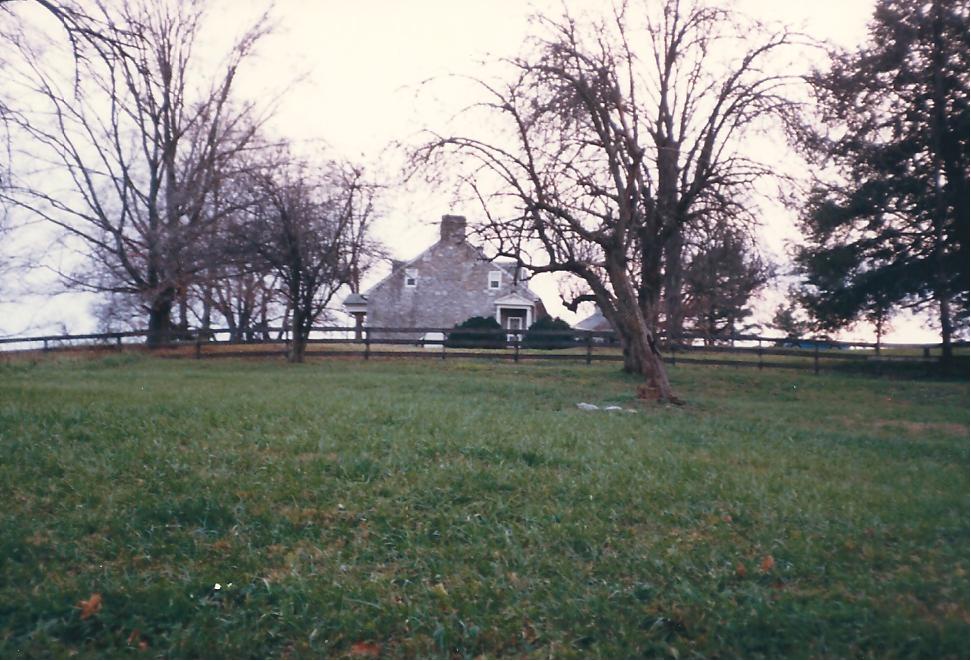 Far off
view of Riverside from the road – photo taken by Judy Ware 2009
Far off
view of Riverside from the road – photo taken by Judy Ware 2009
 Riverside
Riverside
Photo taken by James & Judy Ware - 2009
Directly across the road from Riverside was the mill that James ran as well. It was appropriately renamed “Ware’s Mill.” Both landmarks are still in existence today.
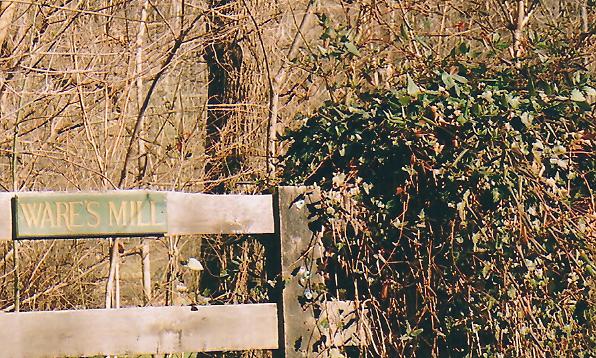

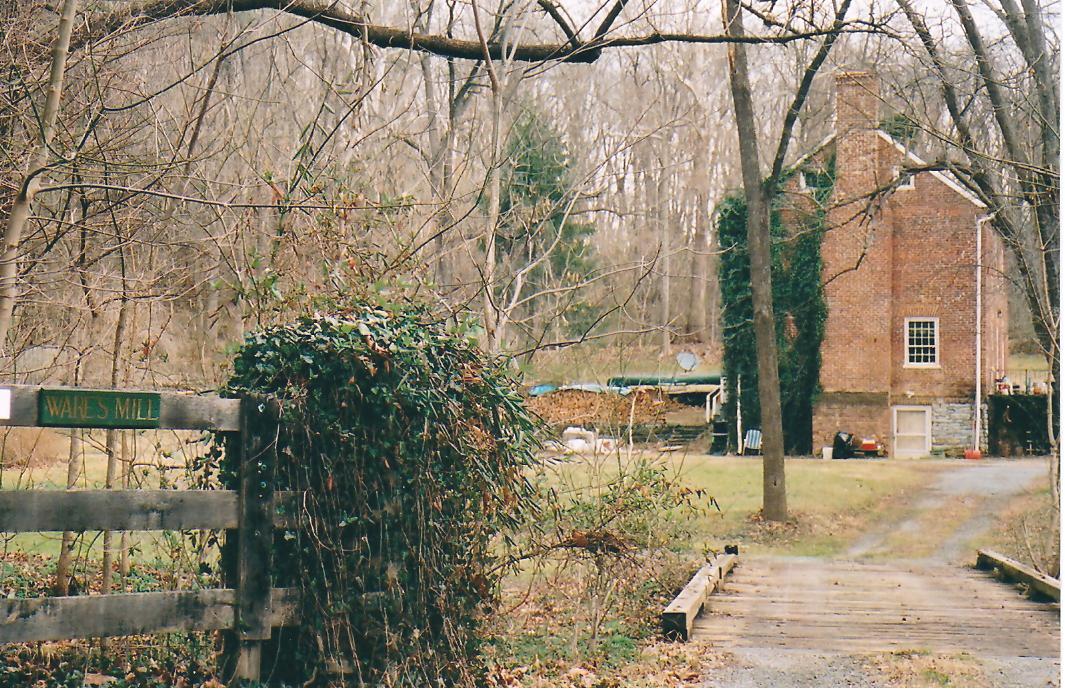 Photos
taken by James & Judy Ware 2002
Photos
taken by James & Judy Ware 2002
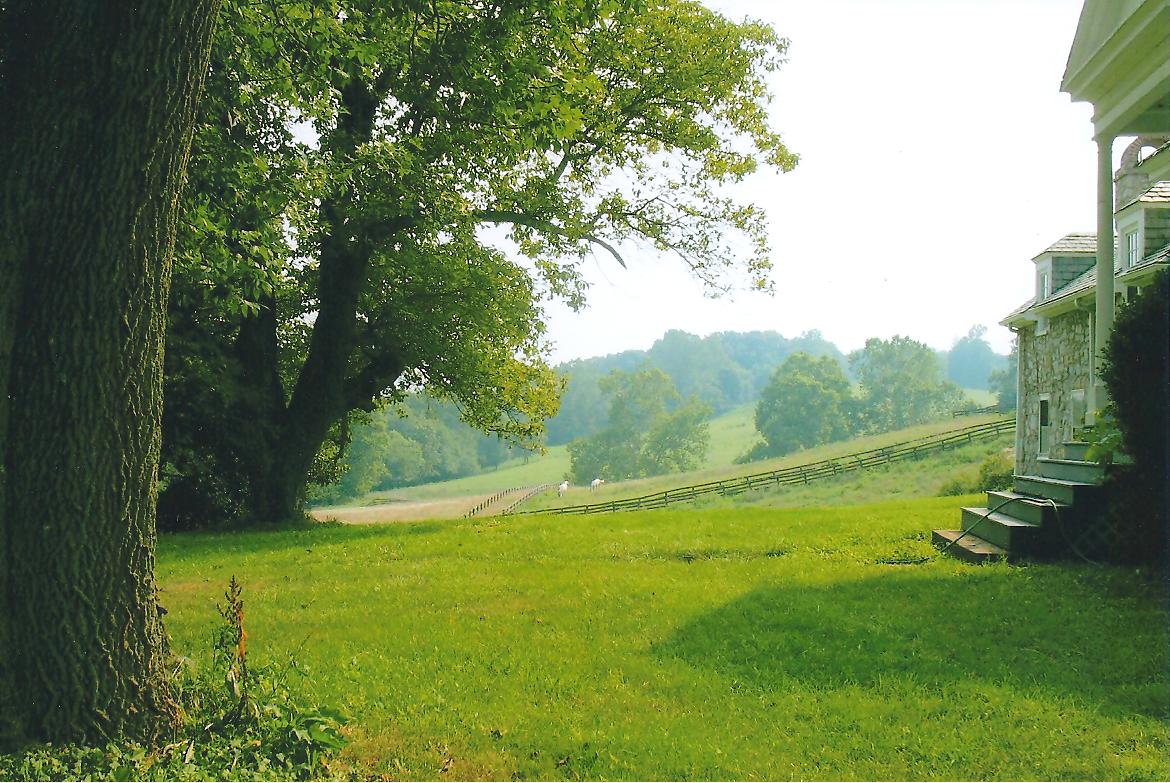
View from Riverside looking down the hill to the Shenandoah River
Photos taken by James and Judy Ware 2009

Ware’s Mill across the road from Riverside
Artist’s sketch of Riverside done in 1929

Above photo courtesy of owners of Riverside in 2007 (Ref. 507)
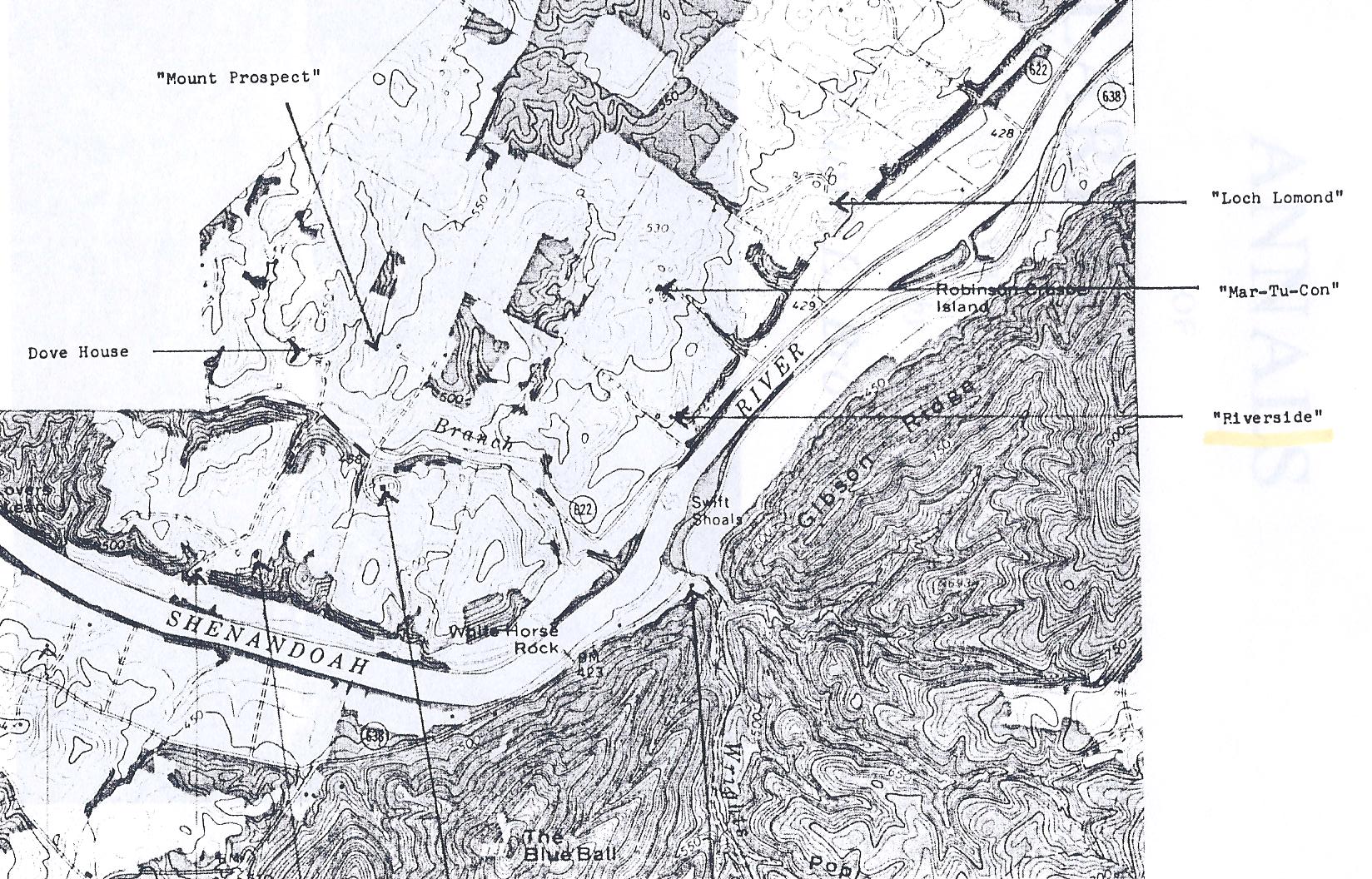 Ref.
259
Ref.
259
Combining the inherited wealth that Elizabeth Alexander brought into the marriage with the “fortune” James was reported to have accrued during his early years working in Louisville, the newlyweds were now in a position to be one of the more affluent members of Frederick County. “The most striking fact about the society of old Frederick was that most of the wealthy lived in the eastern region. The county’s small farmers sensed a profound difference between themselves and the wealthy farmers along the Shenandoah as they customarily described the well-connected sons of Tidewater planters and their prosperous neighbors in east Frederick.” (Ref. 48) Although high land prices had encouraged many, like James’s family, to move from Old Frederick, “tax records clearly demonstrate that from 1782 to 1830 the men who stayed behind did well too.” (Ref. 48)
Shortly after their marriage in 1796, the Wares closed out what was probably their last financial tie in Kentucky. In an indenture record, it states that “On November 5, 1798, James Ware of Louisville, Kentucky (but now of Frederick County, Virginia) and Elizabeth T. (Alexander) Ware; his wife, to Buckner Thurston of Fayette County, Kentucky for 500 Pounds, 204 ¾ acres in Jefferson County on Bear Grass Creek, being a part of a tract and part of the aforesaid survey, thence along a line of James Sullivan’s land, bounded by land of Elias Neale & Bazil Prather.” (Ref. 830) They were now investing their future in Virginia and their new home at Riverside. Nestled at the foot of the Blue Ridge Mountains, “it was considered a show place for miles around.”(Ref. 2) Riverside was “built out of gray stone, was about a story and a half with dormer windows, and it was held in the Ware family for six generations.”
(Ref. 507) It stands to this day, a beautiful home resting on a hill along the Shenandoah River.
 Riverside –
on the hill
Riverside –
on the hill
Home built by James Ware III
View from the back door of Riverside, with the Blue Ridge Mountains on the horizon and the Shenandoah River nestled off to the left (and below) of the tree line.
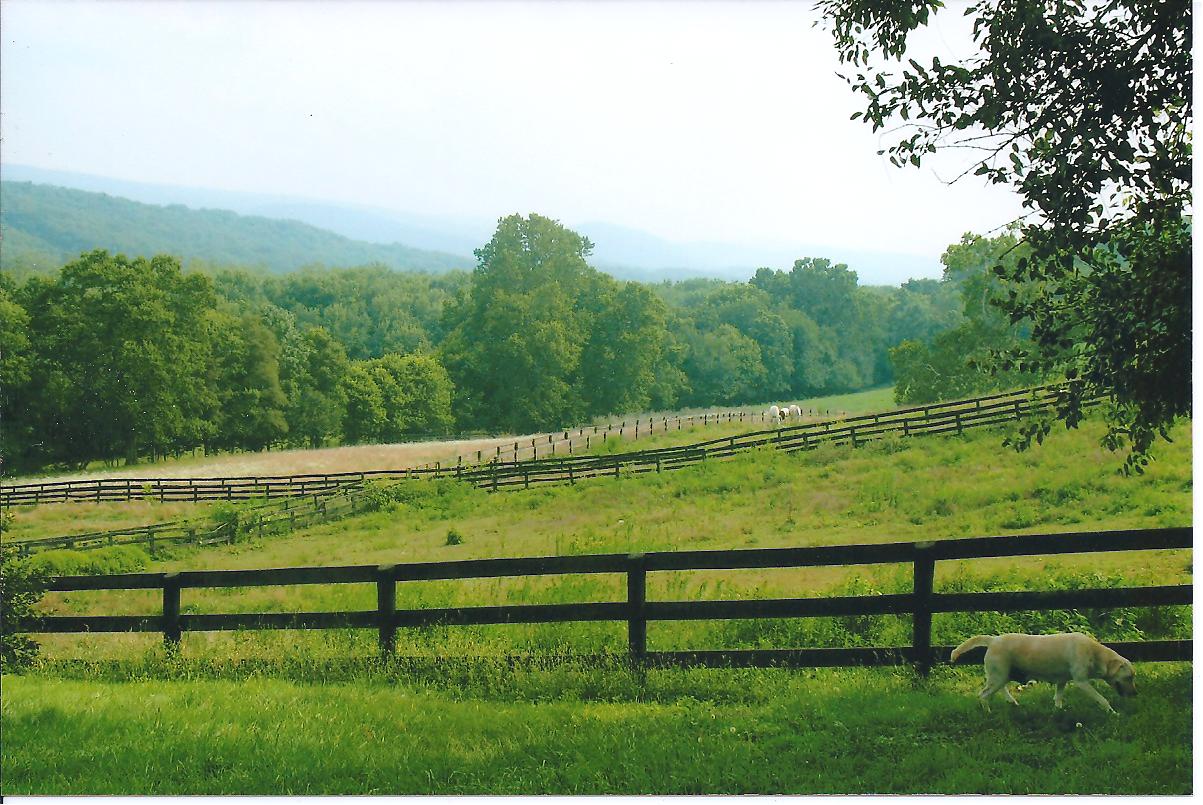
Photo taken by James & Judy Ware 2009
Unfortunately, all the financial security that
blessed James and Elizabeth could not stave off tragedy in their
marriage. They were destined to share only seven short years
together before Elizabeth died of complications from tuberculosis, a
disease she probably, unknowingly, caught from James. Her death
occurred on August 29, 1803, and she was only 29 years old at the
time.
![]() The distraught husband would marry a second time, but the incurable
illness plagued the family. James III and his second wife, Harriet
Milton Taylor Ware, lost five children to tuberculosis and James died
of it himself on a Thursday night, September 13, 1821. Harriet
followed him the next year on Friday night, November 1, 1822. (Ref.
1)
The distraught husband would marry a second time, but the incurable
illness plagued the family. James III and his second wife, Harriet
Milton Taylor Ware, lost five children to tuberculosis and James died
of it himself on a Thursday night, September 13, 1821. Harriet
followed him the next year on Friday night, November 1, 1822. (Ref.
1)
In their few brief years together, James and Elizabeth had three children. The first baby was born just a year after their marriage, on October 1, 1797. The proud parents named their daughter Sarah Elizabeth Taliaferro Ware.
![]() Birth date taken from family
bible
Birth date taken from family
bible
Although her paternal grandparents, James and Caty, and all her aunts and uncles were far away in Kentucky, young Sarah often received letters from them over the years. She married Sigismund Stribling on November 7, 1820. Sarah became pregnant very shortly after their marriage, but tragically, her husband died before they could even celebrate their first anniversary. Sigismund died on October 24, 1821, never getting to know the daughter that would bear a feminine version of his name, Sigismunda. Sarah lived many more years, dying on April 16, 1878.
![]() Death date for Sigismund
Death date for Sigismund
James and Elizabeth soon had a baby brother for Sarah, or Sally as she liked to be called. On July 3, 1800, Charles Alexander Ware was born. Elizabeth was 26 years old at his birth, and James was 29. Charles lived to adulthood, but he died on December 3, 1823, at the young age of 23.
![]() Birth date for Charles Alexander Ware
Birth date for Charles Alexander Ware
 Death date for Charles Alexander Ware
Death date for Charles Alexander Ware
The last child for James and Elizabeth was another son, this one named Josiah William Ware. He was born on August 19, 1802. Young Josiah never really got a chance to know his mother, however, because she died just days after his first birthday, on August 29, 1803.
![]() Birth date for Josiah Ware
Birth date for Josiah Ware
Josiah inherited his mother’s property of Springfield and when he married Frances Toy Glassell in 1827, he built a mansion on the land. Fittingly called “Springfield Plantation,” it was considered a show place in the area.
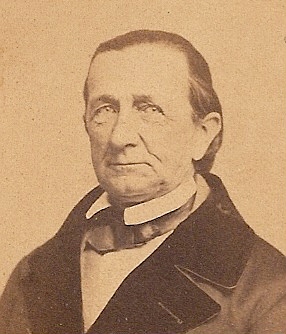
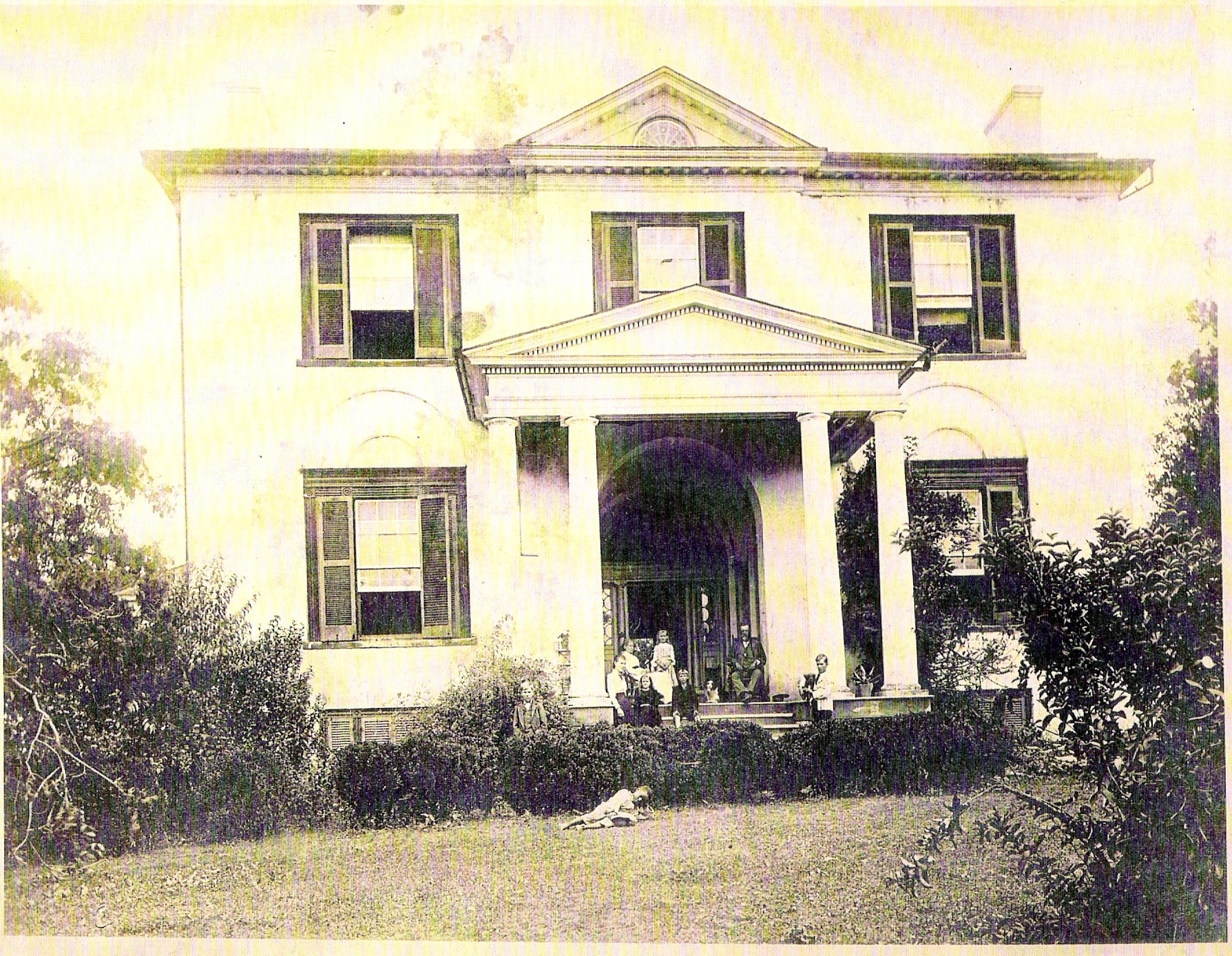 Josiah Ware
Original Springfield
Josiah Ware
Original Springfield
After Frances died in 1842, Josiah married Edmonia Jaquelin Smith in 1845. It was predominately through the line of Josiah and his children that the Ware name continued on in Virginia.
Elizabeth Alexander Ware, so young at her death, left James III with three children to raise, all under the age of seven. He probably felt very gratified to have one member of his immediate family living close by when she died. His younger brother, Charles, had left his new home in Kentucky in the fall of 1793 and gone to live with James in Virginia for a period of time. He later wrote to his niece, “your father and I continued together almost until I married in 1803 and sometime after your amiable and affectionate Mother had quit this world for a more blessed abroad.” (Ref. 35G) Charles was probably a big comfort to his big brother at this sad time.
Five years after becoming a widower, James III married again in 1808; this time to his cousin, Harriet Milton Taylor. They had six children together: James W. (1809), Bushrod (1810), Thomas (1812), Lucy (1814), Harriet (1816), and Elizabeth Alexander Ware (1818), who was named for James’ first wife. Tragically, tuberculosis loomed like a cloud over the family and eventually took the lives of all but one child who lived long enough to marry. James W. died at 18, Bushrod at 7, Thomas Marshall at 20, Harriet at 12, and baby Mary only lived 14 months. The dreaded disease also killed both James and his wife; James in 1821 and Harriet in 1822.
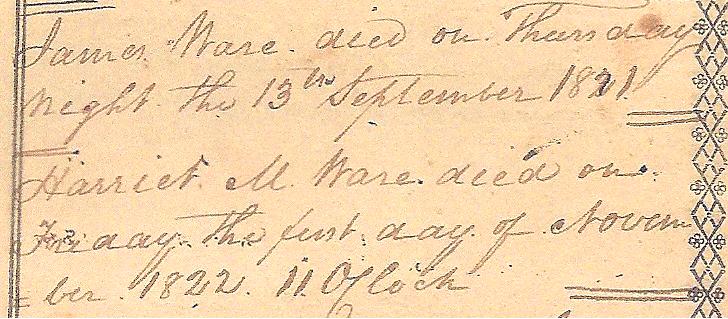 Taken from family bible
Taken from family bible
owned by James & Judy Ware
The children James had with his first wife (Sarah, Charles, and Josiah) were adults and on their own by the time their father and stepmother died, but that still left four orphans (James, Bushrod, Thomas, and Harriet) from the second marriage who needed raising. Josiah and Charles were unmarried bachelors at the time, and Sally Ware Stribling had just recently given birth and become a widow, all in a very short span of time. Fortunately, before her death, Harriet Ware had already asked if her brother Bushrod and his wife, Betsey Stribling Taylor, would be willing to raise her children if anything happened to her. Harriet must have lived with a great sense of impending sorrows.
 (Photo
Ref.900)
Betsey had no children of her own and lovingly adopted these four
little ones. She “petted, loved, protected,
and laughed with the children, striving to lessen their sense of
loss.” (Ref.
900) In every sense of the word, she became a
mother to these Ware siblings and it must have broken her heart to
have to bury most of them. “Marshall was
the third of the Ware orphans to die and his loss was the most
difficult for Betsey to accept.” (Ref.
900)
(Photo
Ref.900)
Betsey had no children of her own and lovingly adopted these four
little ones. She “petted, loved, protected,
and laughed with the children, striving to lessen their sense of
loss.” (Ref.
900) In every sense of the word, she became a
mother to these Ware siblings and it must have broken her heart to
have to bury most of them. “Marshall was
the third of the Ware orphans to die and his loss was the most
difficult for Betsey to accept.” (Ref.
900)
Lucy Catherine Ware was the only child who lived long enough to marry. She wed Dr. William McGuire and they lived at Riverside, the home her father built in his youth. (Ref 590, 899, 900) It was held in the family for six generations and still stands to this day.
Deaths recorded in Ware Family Bible
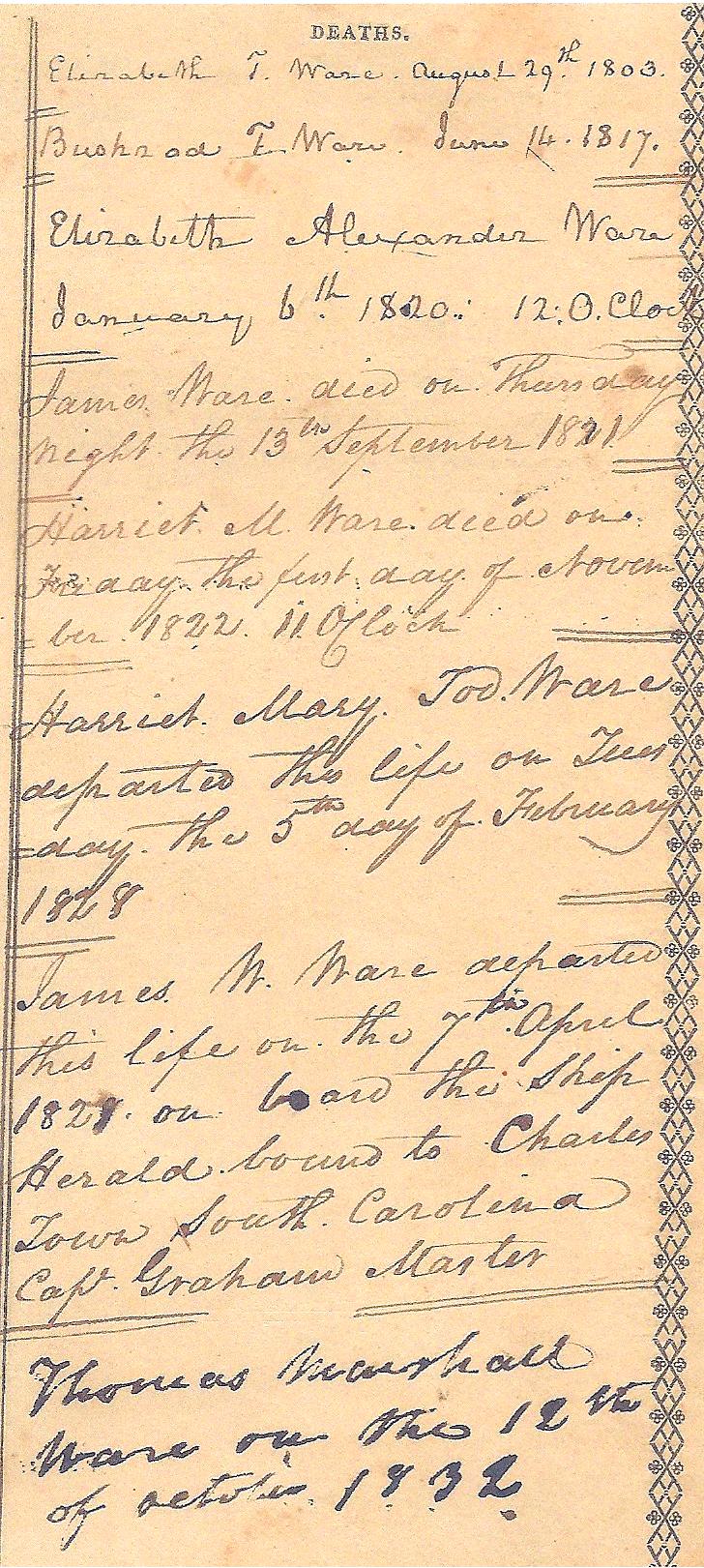 Elizabeth
T. Ware August 29th, 1803
Elizabeth
T. Ware August 29th, 1803
Bushrod T. Ware June 14, 1817
Elizabeth Alexander Ware January 6th, 1820 12:O'Clock
James Ware died on Thursday
night the 13th September 1821
Harriet M. Ware died
on Friday the first day of November 1822 11O'Clock
Harriet Mary Todd
Ware departed this life on Tuesday the 5th day of February, 1828
James W. Ware departed this life on the 7th April 1827 on
board the ship Herald bound to CharlesTown S. C.
Thomas Marshall Ware on the 12th of October 1832
James and Caty Todd Ware never got to see their grandchildren in Virginia very often. Letters helped bridge the gap, but illness and distance made it next to impossible for frequent visits. None the less, family ties remained strong. The generation of cousins made a concerted effort to stay in touch and they got together as often as they could. The family closeness is reflected in a portion of a letter sent from Lucy Ware Webb to her brother James’ daughter, Sally Ware Stribling.
“I now find no room to write Josiah, but give my warmest love and affection to him and his wife. I want much to see you all and Sigismunda [Sally’s daughter]. Tell him [Josiah] I often look at my breast pin and think of him. I can consciously say, though I write seldom, you will ever be remembered by me as wonderful, beloved relations. Tell Josiah that if my life and health is spared, I will write him in a month or two. Farewell, my dear relations. May God forever bless, protect, and direct you through life will ever by my prayer.”
Lucy Webb
~~~~~~~~~~~~
The branches of the Ware tree were now fully growing strong in both Kentucky and Virginia - - - forever bound together by aunts, uncles, cousins, and love.
![]()
Supporting Documentation for Chapter 3
CHILDREN OF:
JAMES WARE III and ELIZABETH ALEXANDER WARE
B. January 13, 1771 B. Oct. 26, 1774
D. Sept. 13, 1821 D. Aug. 29, 1803
James was the son of Dr. James Ware II and his wife, Caty Todd Ware. He was also the grandson of James Ware I and his wife, Agnes Todd Ware. He traveled to Kentucky but ultimately settled back in Virginia where he married Elizabeth Alexander Ware on Nov. 10, 1796
(1) Sarah Elizabeth Taliaferro Ware – born Oct. 1, 1797 died April 16, 1878
Married Sigismund Stribling Nov. 7, 1820
(2) Charles Alexander Ware – born July 3, 1800 died Dec. 3, 1823 at age 23
(3) Josiah William Ware – born Aug. 19, 1802 died Aug. 13, 1883
Married Frances Toy Glassell on Feb. 22, 1827 and Edmonia Jaquelin Smith on Jan. 30, 1845
CHILDREN OF:
JAMES WARE III and Harriet Milton Taylor (2nd wife)
B. January 13, 1771 B. April 26, 1790
D. Sept. 13, 1821 D. Nov. 1, 1822
When his 1st wife, Elizabeth Alexander Ware, died at a young age, James remarried – this time to Harriet Milton Taylor on March 17, 1808
(1) James W. Ware – born Feb. 1, 1809 died April 7, 1827 age 18
(“on board the ship Herald bound to CharlesTown, South Carolina”)
(2) Bushrod Thomas Ware – born Sept. 10, 1810 died June 14, 1817 age 7
(3) Thomas Marshall Ware – born July 3, 1812 died Oct. 12, 1832 age 20
(4) Lucy Catherine Ware – born July 26, 1814 died April 5th, 1838
Married Dr. William D. McGuire
(5) Harriet Mary Todd Ware - Nov. 21, 1816 Feb. 5, 1828 (Tuesday) age 12
(6) Elizabeth Alexander Ware – born Nov. 6, 1818 died Jan. 6, 1820 (14 months)